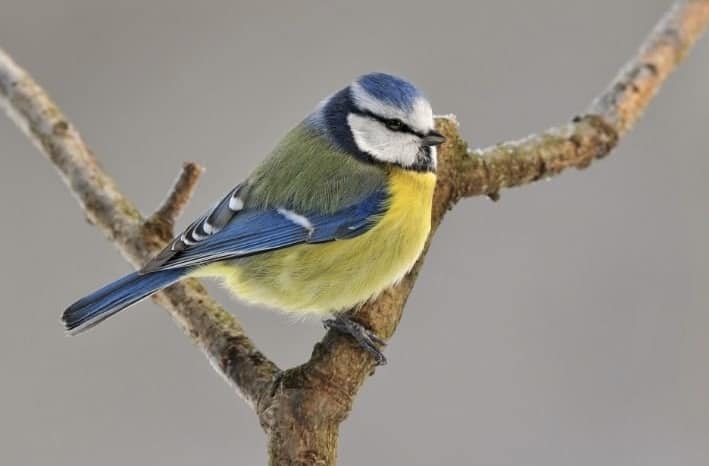Blue Tits are a fascinating bird to observe in the garden. There are approximately 3.5 million pairs of these adorable birds throughout the U.K. and Ireland. Blue Tits are therefore extremely common in rural settings, leaving many people wondering if they see the same birds annually.
Blue Tits are fairly indistinguishable from one another, except between male and female colourations, so determining if the Blue Tit that frequents your garden is the same one from a previous year is difficult.
In general, Blue Tits do not migrate in the sense of long-distance movements. They have been known to travel great distances over their lifespan, but not in the same way that some birds migrate annually as a species. A Blue Tit may travel an average of 20 kilometres away from its home, but they are generally sedentary birds and will not leave the area in which they were hatched. However, Blue Tits that are hatched in northern regions, or climates that experience extreme cold in the winter, may migrate south for a while in the winter.
When & Where Blue Tits Migrate
Blue Tits native to the U.K. only migrate in the winter, if they chose to migrate at all. The small percentage of Blue Tits that occasionally migrate, approximately 1.2%, move an average of 20 kilometres away from where they were hatched.
If you notice an influx of Blue Tits in your area, they are most likely northern European Blue Tits that made their way into the U.K. for a warmer winter. If a Blue Tit’s nesting ground is not warm enough during the winter, they will move down the road to survive.
Another reason that some Blue Tits travel during the winter is for food. If food is scarce they will set out in search of sustenance to make it through the colder months.
Blue Tits That Don’t Migrate in Winter
The majority of Blue Tits do not migrate, as they are predominantly a sedentary bird species. Most of these birds will stay near the area in which they were hatched unless food and shelter are not available. If resources and protection are scarce, they will migrate an average of 20 kilometers away.
The main reason why most Blue Tits do not leave their nesting grounds is because of human influence. Blue Tits are huge fans of birdseed mixes, fat balls, and suet cakes that are offered by humans in their gardens. As long as feeders are filled year-round, Blue Tits will frequent them and, in some cases, rely on them as their main source of food.
Blue Tits will also shelter in man-made nesting boxes if any are available in your garden. It is recommended to place nesting boxes 2 to 4 meters off the ground and facing a northeast position. Although this recommendation is based on Blue Tit’s nesting habits, it is good for sheltering from winter weather as well.
Do Blue Tits Migrate in Summer?
Generally, Blue Tits do not migrate in the summer months. If you are noticing a smaller number of Blue Tits in your area, it could be because they are feasting in the countryside.
Blue Tits will feast in the late-summer, early-autumn months on the abundant seeds and berries that can be found in the wilder areas of the region. They do this to stock up for the winter and create fat stores to help stave off the colder temperatures.
Although they might be missing from your garden, continue filling the feeders with Blue Tit’s favourite foods and they will return once they have had their fill. Since Blue Tits are fattening up for the winter months, it is recommended to put out suet cakes, peanuts, or fat balls to help them in their endeavours. They will certainly thank you with their acrobatics upon their return.
Conclusion
In conclusion, Blue Tits do not generally migrate as a species. There are a small number, approximately 1%, of Blue Tits that will occasionally migrate an average of 20 kilometers away from where they were hatched. Blue Tits are sedentary birds, so once they hatch they tend to stay in the same area for the rest of their lives.
Although a Blue Tit’s average lifespan is 3 years, it is not uncommon to see the same family of Blue Tits and their subsequent generations year after year. The Blue Tits that do not migrate in the winter will rely heavily on any bird feeders in the garden. Their favourite foods include peanuts, suet cakes, and any type of wild bird seed mix. Ensure they have access to food and water throughout the winter months.
Additionally, Blue Tits will frequent man-made nesting boxes as long as they are placed in an ideal location for nesting the following spring. If you see a decline in the Blue Tit population around your garden in late summer, it could be because they are feasting in the wilder countryside to create fat stores for the winter.
Since Blue Tits do not migrate as a species, they will be back in your garden before the cold weather arrives.
You May Also Like…
- What Do Blue Tits Eat
- Do Blue Tits Migrate: When, How & Why Blue Tits Migrate
- What Do Blue Tits Eat? The Natural & Human-Offered Diets of Blue Tits
- When Do Blue Tits Nest? Nesting Habits & Timing For The Blue Tit
- The Difference Between Male & Female Blue Tits
- Blue Tit Or Great Tit? How To Tell The Difference
- The Average Lifespan Of A Blue Tit
- When Does Blue Tit Nesting Occur
- How Many Broods Do Blue Tits Have? Everything You Need To Know About Blue Tit Eggs & Nesting
- Birds In Summer: Where Do Blue Tits Go In The Summer Months?
- How Long Do Blue Tits Live For? The Life Cycle Of A Blue Tit
- Where Do Blue Tits Go In Winter

